Setting key performance indicators (KPIs) is an important part of building a content marketing and search engine optimization (SEO) channel. However, setting the right KPIs is often quite difficult due to the many factors that impact content performance and search engine rankings.
Your KPIs will largely be determined by the stage of your content marketing channel. For new websites, KPIs might be focused on leading indicators of success, like search impressions or the number of keywords you’re ranking for. But as the size of your channel grows, your KPIs will typically shift further down the funnel to metrics like traffic and, ultimately, closed revenue or pipeline.
In this article, we’ll break down our methodology for thinking about KPIs for your organic search channel by stage and by importance, and we’ll provide nine KPIs to consider in your next goal-setting session.
Thinking Critically About KPIs by Stage
KPIs can vary dramatically depending on the stage of your content marketing strategy and the strengths and quality of your domain, including its domain authority. For new websites, initial KPIs should be focused on the leading indicators of success, whereas for an established domain, you’ll likely be able to move faster and have a larger business impact.
KPIs for Months 1 to 3
Assuming that your website is relatively new, the first few months of building an SEO channel will be frustratingly slow. For one, it takes time to do keyword research and to create fantastic content. But it also takes time for search engines to index and rank your content.
And you may have heard that Google has a sandbox, which limits the visibility of new websites in organic search. While Google has denied that a sandbox exists, there are algorithms dedicated to understanding new websites and introducing them to organic search, which explains this phenomenon.
In the first few months of building an organic search channel, I would focus on the inputs to building the channel and search impressions, for example:
- Number of primary keywords identified to create content for
- Number of content outlines created
- Number of high-quality articles published (for instance, one article per week)
- Building processes for content creation
- Number of search impressions, both branded and non-branded
You’ll find that it typically takes about two months of consistent work to break out of the sandbox and get Google to start paying attention. At Positional, we put in about two months of consistent effort before we saw an initial spike in search impressions:
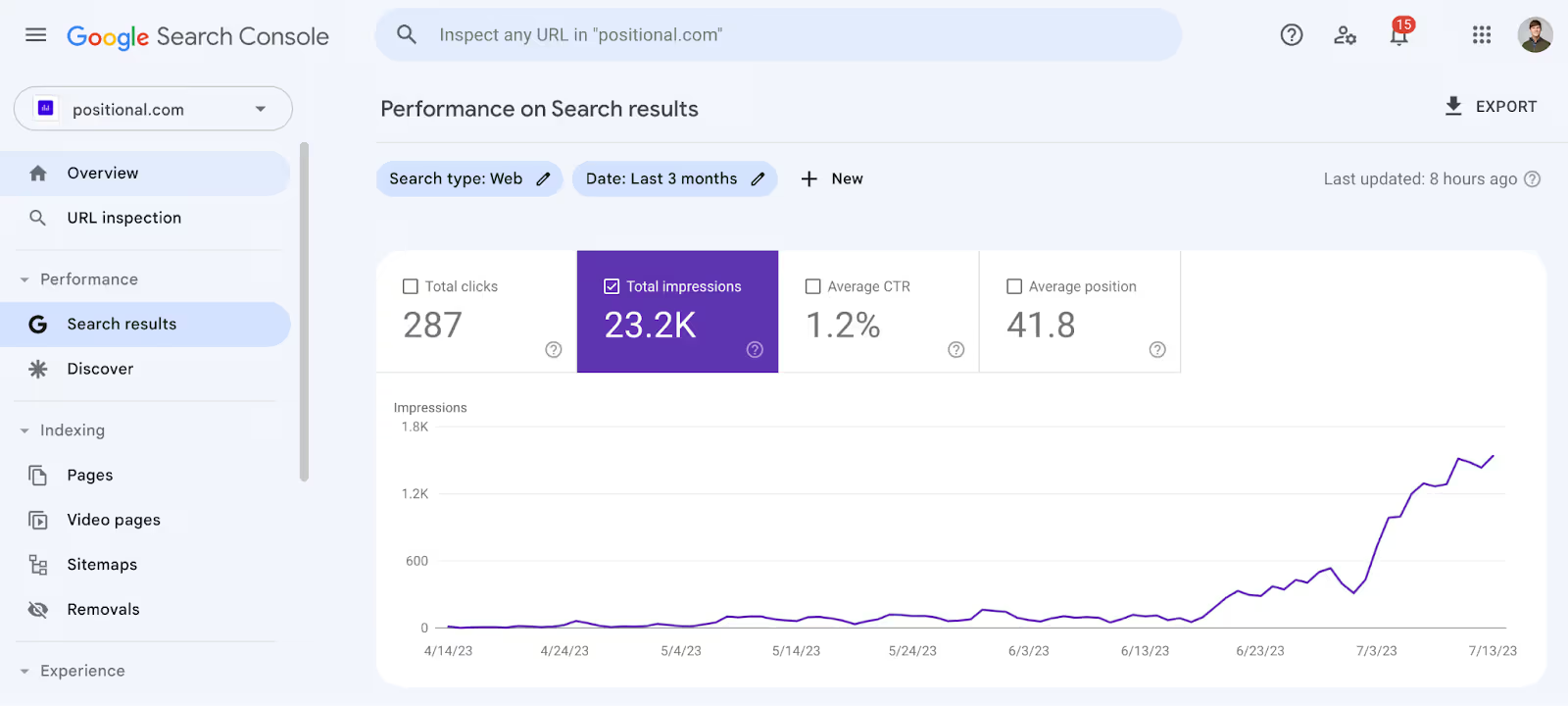
KPIs for Months 6 to 12
A spike in search impressions is typically a leading indicator that traffic will follow. As you get a few months into building your channel, you’ll start to see that Google is testing your website, trying to understand what it’s about and whether it’s a good resource for searchers.
After the initial spike in search impressions and rankings, it’s time to start thinking about scaling the channel. You’ll find that you’ll typically hit different inflection points in traffic, usually around months three, six, and 12, as you continue to put in consistent effort.
At about month six, I would consider setting some slightly different KPIs, including:
- Number of visitors per month from organic search
- Average ranking position for high-value or important pages
- Benchmarks for user experience metrics like bounce rate, time on page, and scroll depth
- Establishing processes to improve and optimize previously published content
- Laying in a small backlink-building campaign (for example, a handful of guest posts)
- Benchmarks for conversion rate and the placement of CTAs on pages
Now that your channel is moving in the right direction, creating new content can get addicting, and you’ll notice that your new posts will rank faster in search for the keywords you care about, thus driving incremental traffic to your website faster. And at this point, intentionally building a number of backlinks can help to throw fuel on the fire and accelerate things.
And now that you’re generating meaningful traffic, you can start to think about the ROI of the channel and on conversion rate.
KPIs for Month 12 and Beyond
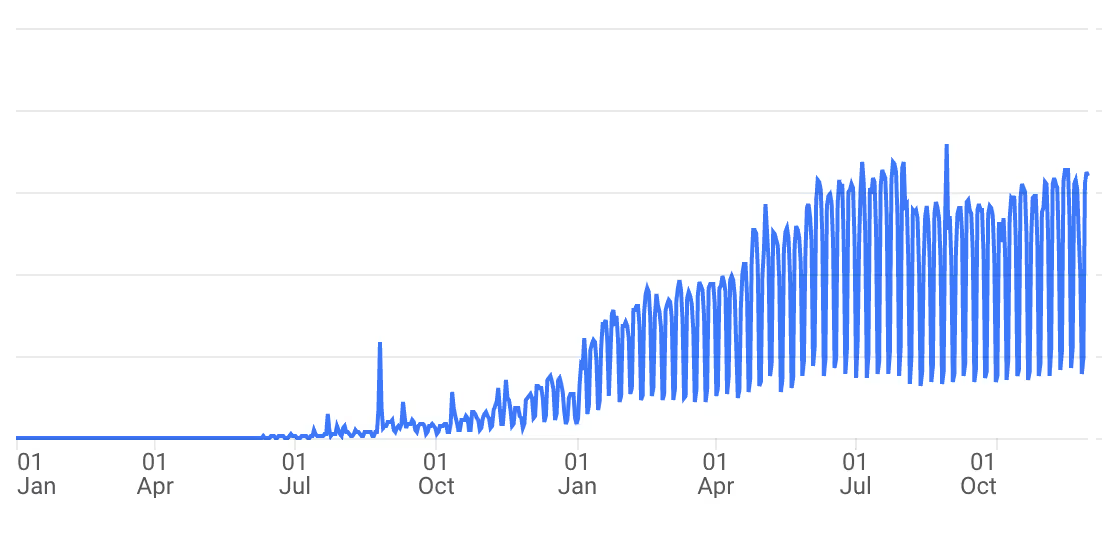
As you approach the one-year mark, traffic and rankings should be improving at a faster pace. At our last company, traffic scaled quickly from about 50k visitors per month from organic search at month six to more than 150k visitors per month from organic search at month 12 — and then to more than 200k visitors per month from months 12 to 14.
Google knows what your website is about and who it’s helpful for, and hopefully, sees that searchers are enjoying your content. By this point, you’ve largely figured out how to pick the right keywords and create fantastic content, and you’ve started thinking about conversion rate optimization.
By about the one-year mark, you’ve probably created a portfolio of content (for example, 52 articles if you’ve been doing one per week), and you should actively be thinking about how to go back and improve what you’ve already published. For example, you could start thinking about the following:
- Number of articles reworked and improved
- Percentage changes or improvements in user experience metrics
- Doing a site audit to improve technical SEO, improving Core Web Vital metrics like FID or LCP
- Optimizing internal link structure and reducing the number of orphaned pages
- Fixing keyword cannibalization issues
- Improving title tags to increase click-through rate (CTR) from organic searches.
You should continue to publish new content if there’s still a universe of keywords you’d like to cover in your niche, but now the highest-leverage activity is improving what you’ve already created.
And at this point, you’re likely driving enough traffic to substantially test your CTAs and improve conversion rates across your pages. You should actively think about your buyer journeys, CTAs, and the placement of those CTAs throughout your website. At the end of the day, you’re building this channel to drive additional conversions and revenue, and you can start to optimize with that as your north star.
9 Important SEO KPIs to Track
If you’ve made it this far into this article, you likely have some good ideas for KPIs to set for your content marketing and SEO team as it grows. Here, we recap and expand on some of the important SEO metrics and KPIs we’ve quickly mentioned already.
KPI #1: Search Impressions
Search impressions are a good KPI for an early-stage SEO channel. As the size of your website grows, Google will be actively testing your pages, and you’ll typically see a spike in search impressions before you see a spike in search traffic.
In Google Search Console, go to Performance: Search Results to see the number of total impressions in Google Search:
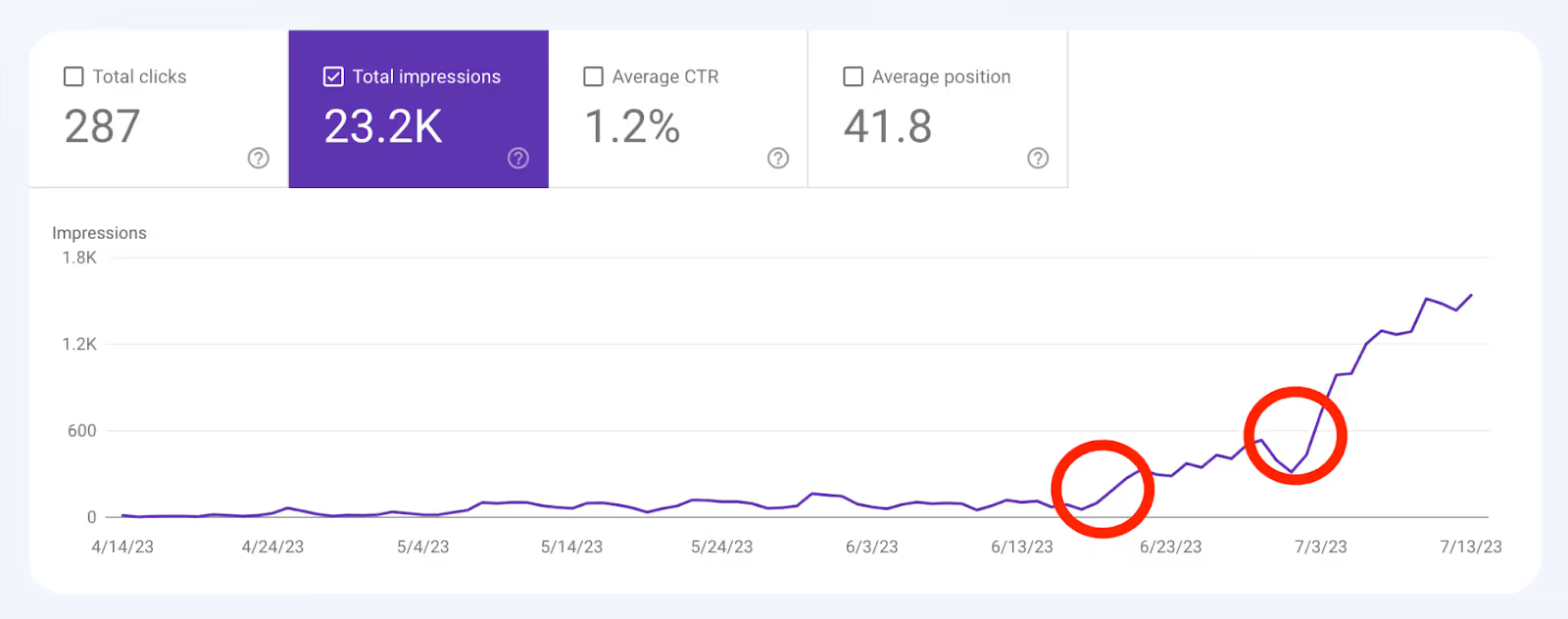
At Positional, it took us about two months and about 20 pieces of content to get Google’s attention. And you’ll notice that we hit two different inflection points where Google started testing our content with additional searchers.
KPI #2: Number of Keywords
The number of keywords you’re ranking for is often a good KPI for an early-stage team. There are a large number of tools for tracking keyword rankings and performance, but if you’re on a budget, you can use Google Search Console to track keyword performance.
In Google Search Console, under the Performance tab, you can view the keyword or queries that your pages are appearing for. You can export these queries, and if you’re technical, you can use the Google Search Console API to pipe your queries and average ranking position anywhere you’d like.
The number of keywords you’re ranking for is going to be highly correlated with search impressions, although search impressions also account for the position or ranking of your page in search results.
On a page-level basis, you can certainly set individual KPIs for specific pages on your website — for example, the number of keywords that a specific page is ranking for.
KPI #3: Organic Traffic
Ultimately, we’re all looking to drive additional traffic to our websites from organic search. As your content and SEO channel mature, traffic will often become one of the leading KPIs to track.
In Google Search Console, under the Performance tab, click on Search Results, and then click on Total Clicks to see your traffic from Google Search over time:
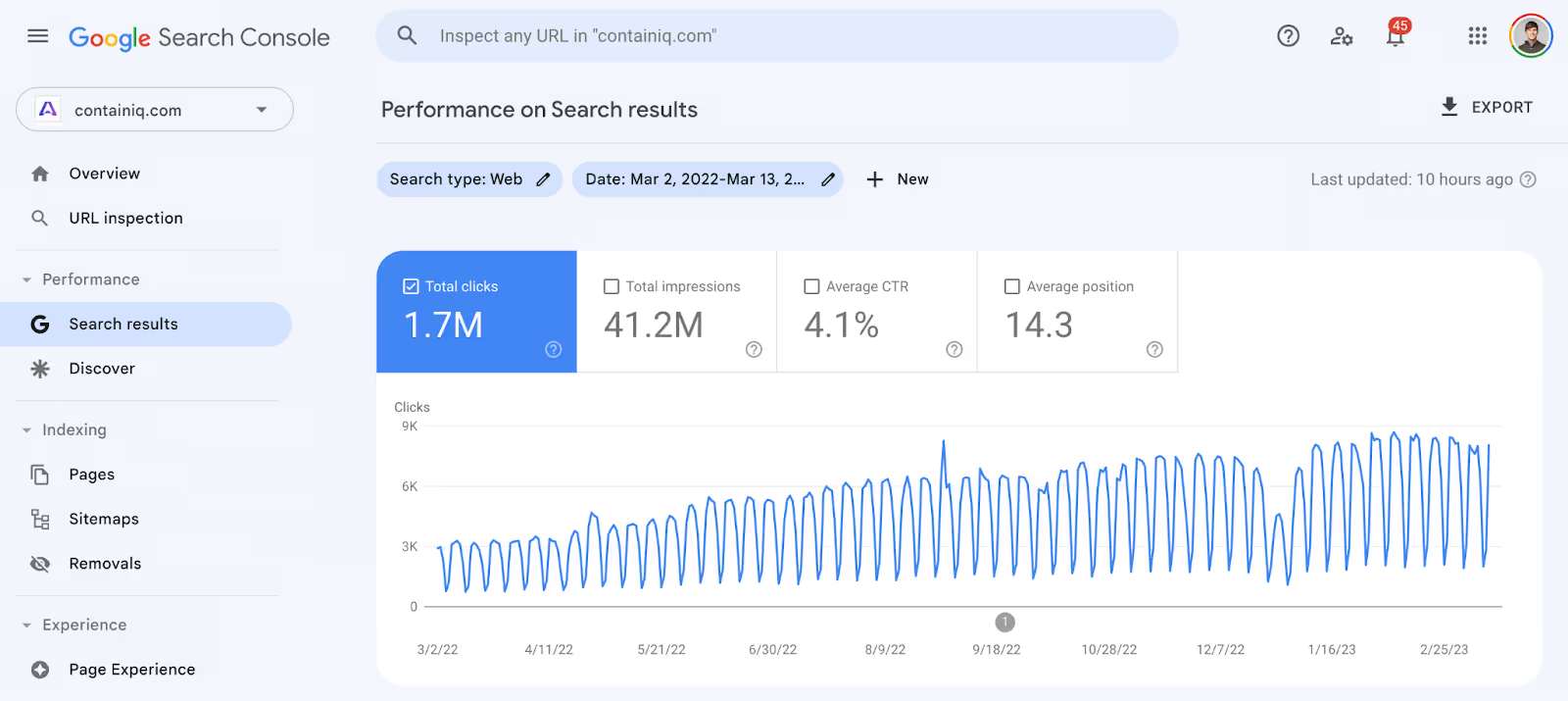
At our last company, we drove about 1.7 million clicks from Google’s organic search results over about a one-year period, which was our second year of building our organic search channel.
However, setting organic search traffic as a KPI is often very difficult. As you know, Google’s algorithm is constantly changing, and updates to the algorithm can lead to significant positive and negative movements in traffic. In addition, the impact of all the positive work you do will typically be delayed. The work you do in Q2, for example, might not impact organic traffic until Q3 or even early Q4.
Of course, you can set traffic goals for specific pages on your website, and you can track the performance of single pages using Google Search Console too.
KPI #4: CTR from SERPs
Your CTR from the search engine results pages (SERPs) has a really big impact on the amount of traffic you can drive for a specific keyword and on the actual rankings of a given page in organic search.
As your site grows, it makes sense to analyze CTR on your most important or high-traffic pages. You can set a KPI on CTR for a specific page on your website. Your CTR is largely determined by your ranking position but impacted significantly by your title tags and meta descriptions.

You can actively test and update your title tags and meta descriptions for engagement and CTR. In Google Search Console, you can track CTR at a page level by selecting a page in the Search Results tab and then by clicking on CTR. Even small improvements to a title tag, for example, can lead to significant improvements in traffic and rankings for that page.
KPI #5: Average Ranking Position by Page
You can set KPIs on the average search engine rankings for a specific page, and you can use the average ranking position to flag which pages you should come back to and improve. There are, of course, pages on your website that are more valuable — for example, a high-intent page where someone is actively searching for your product or service — and you should prioritize these pages.
You can track the average ranking position for your entire website, as well as ranking positions for specific pages, in Google Search Console under the Performance: Search Results tab. There are, of course, plenty of rank tracker tools to use, too, like Ahrefs and Semrush.
If you have a large number of pages stuck in positions nine through 30, you should come back to these pages and try to improve them or reoptimize them for the keywords in focus. Even small changes in ranking for a given keyword can lead to significant increases in traffic; for example, going from the 12th spot to the fourth spot for a given keyword could increase traffic for that keyword by five to 10 times.
KPI #6: User Experience Metrics
Google uses engagement metrics like bounce rate, time on page, and scroll depth to determine whether searchers have a good experience on your website. Of course, there are many additional metrics, like pages per session and return to search rate.
You should be actively setting KPIs on the user experience metrics of your pages — for example, the bounce rate for a specific landing page or the scroll depth on a specific blog post. Even small improvements to a page could reduce bounce rate or increase scroll depth. UX and UI are also very important when it comes to ranking well in search, as your page’s appearance has a big impact on user experience metrics.
Coming back to existing webpages and improving them is important. You should actively flag pages that are below the baseline or where the user experience metrics are worse than other pages on the website.
KPI #7: Backlinks and Domain Authority
Backlinks still play an important role in a website’s organic search rankings. While Google no longer publicly displays PageRank for your website, there are a number of SEO tools that provide estimates for domain authority or domain rating.
While it’s difficult to set a KPI for domain authority or domain rating, you can certainly set KPIs for the number of backlinks or referring domains pointing to your website. By building backlinks, you can help accelerate the rankings of your pages in organic search results. And for companies in highly competitive industries like consumer finance or consumer health, building backlinks is an even more important part of the process.
There are many different ways to build backlinks, including guest posts, building resource page links, creating data-driven content, and creating link bait. In a recent podcast episode with Jeffrey Trull, Jeffrey described (at 16:10 in the podcast) how he used link bait — or, in other words, content designed to accumulate links — to drive more than 4,000 referring domains to his website.
As always, building a lower number of high-quality backlinks is better than building a large number of low-quality links.
KPI #8: Core Web Vitals
The SEO community loves to debate the importance of Core Web Vitals. Core Web Vitals are metrics that judge the real-world user experience of your pages: for example, the page speed or interactivity of your page. For most websites, Core Web Vitals are something to worry about once you’ve already made substantial progress on building an organic search channel.
For an established website, setting a KPI on improving the Largest Contentful Paint (LCP) metric is a worthwhile goal. In Google Search Console, Google provides Core Web Vitals data:
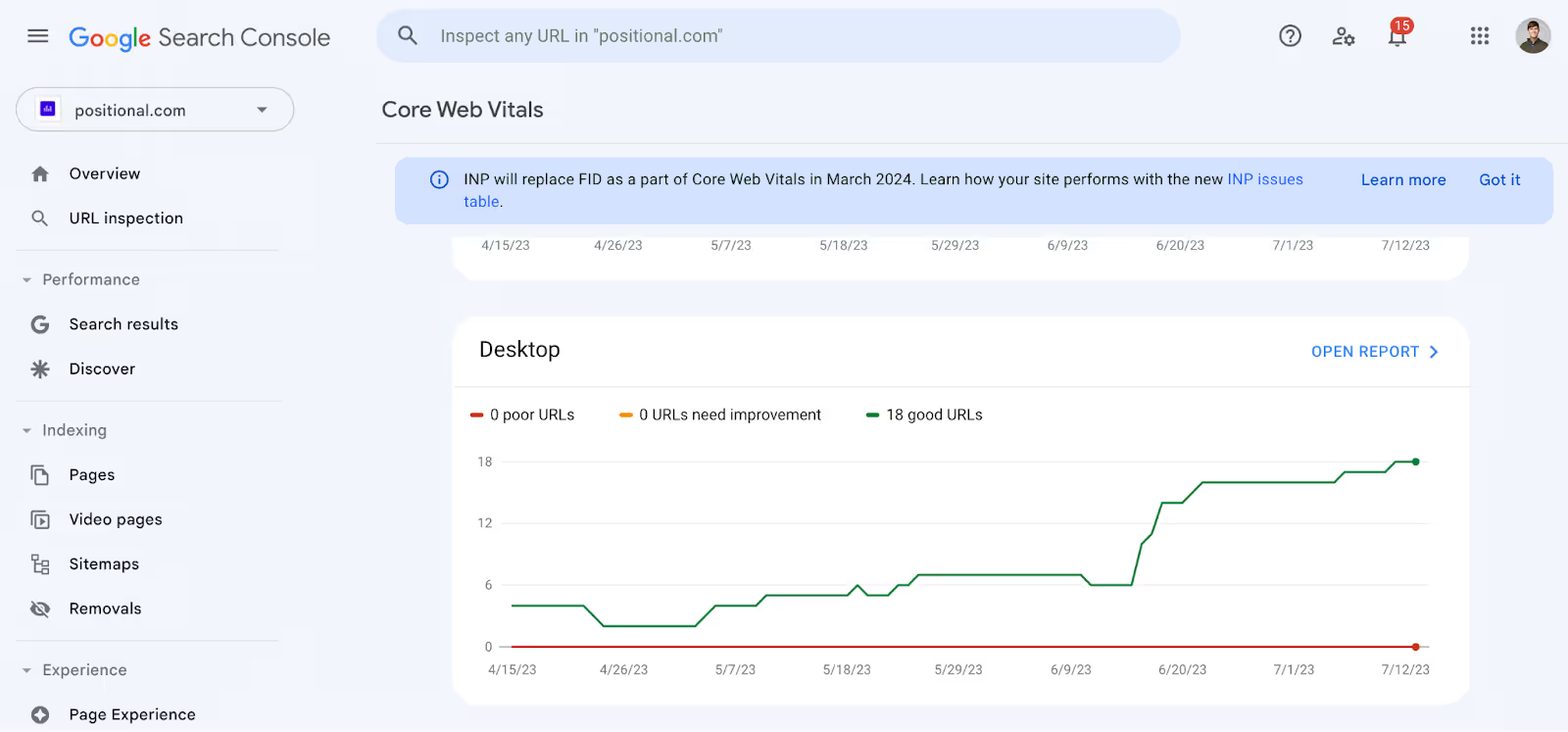
There are also tools, like Google PageSpeed Insights and the PageSpeed Insights API, that provide performance data and recommendations for improving performance.
KPI #9: Conversions and Pipeline
Conversions, pipeline, and revenue will become the most important KPIs for your SEO channel.
Once you’ve built a substantial channel and you’re driving significant traffic to your website, you should be actively working on optimizing your conversion rate — or the rate at which you can turn a visitor into a lead or customer. Even small improvements to the copy and placement of a CTA can lead to a significant increase in conversion.
A mistake that companies often make is to use the same CTAs for each page on their website. You should work to map your CTAs to the stage of the funnel of a particular page. For example, a CTA for collecting email addresses for your newsletter might work well within a piece of evergreen content, whereas a direct CTR for a free trial might perform best on a piece of content further down the funnel, such as a page comparing different tools or competitors for a product or service.
Thinking critically about your CTAs, and the types of content and keywords you target is time well spent. There are plenty of tools available for tracking conversions and the performance of your CTAs, including tools like Google Analytics.
Final Thoughts
Setting KPIs for your content marketing team and SEO strategy is often a difficult task, and your goals will change over time as the size of your website grows. In your next quarterly meeting, push yourself to set quantifiable KPIs on the inputs to growing an organic search channel.
For early-stage websites, focusing on leading indicators of success, like the number of articles published or search impressions, is often a good place to start.
As your website grows, you should be setting SEO KPIs on further-down-the-funnel metrics like traffic and, ultimately, revenue. Along the way, you should actively work to improve the existing pages on your website, build backlinks to accelerate rankings and improve the user experience and performance of your website.
If you need help hitting your SEO KPIs and improving SEO performance or search engine visibility, I’d encourage you to take a look at Positional. At Positional, we’re building a toolset for content and SEO teams, including tools for content optimization, technical SEO, and keyword strategy.





